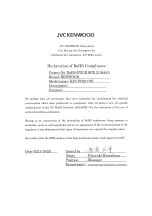
SV Subwoofers
Page 8
speakers, as
well
as your sub, getting these bass wave forms to arrive in a com
complementary,
enhancing
fashion is the difficult job of the phase control. Essen-
tially, “phase” varies the timing of the bass waves coming from the sub. But don’t
despair if you don’t hear much difference; the effect of bass cancellation will vary
by volume and frequency in your room, and no one setting is likely to ever be
“perfect”. One simple technique to optimize phase is to find a nice “bassy” loop
(such as the menu of “Godzilla”) and measure the loop’s SPL response at various
bass peaks. As the loop runs, you can have an assistant adjust the phase control.
When you see the most response on a given bass passage, typically that’s the set-
ting with the least cancellation (for the frequencies of the demo loop).
L
ine In/Out.
Use one of the sub’s “Line In” jacks to connect the subwoofer to the
output jack of your receiver/processor. Feeding just one input is enough. If you
are using a conventional amp and/or a stereo setup you can use the “Line Out”
jacks to send sound (filtered of bass information) back to your system amp. A
simple RCA to RCA cable is all you need.
A
uto On.
Your Powered Box allows itself to be in an “auto on” mode… or on all
the time. With the former setting (the switch in the “Auto” position) your sub-
woofer will “sense” that a DVD or CD etc. has begun and switch on immediately
(the “hard” power switch mentioned below must be on naturally). A few minutes
after a movie, the Auto On light will turn Red, switching the sub back off. When
running (and sensing a signal) the Auto On LED will be green. Sometimes, with
very low listening levels, your subwoofer might not get enough of a bass signal
from your surround sound processor to “trip” the Auto-On circuit. Should you
ever find this to be the case you may leave this switch to “On”.
C
rossover Enable Switch.
If you allow your DD/DTS surround-sound receiver
or processor to manage bass frequencies (recommended), this switch should be set
to “Disabled”. This disables the “Crossover Frequency” knob and allows your sub
to reproduce just what it’s fed from the receiver. If you use the sub in a two chan-
nel (stereo only) configuration, then “Enable” the crossover and adjust the associ-
ated knob to best blend the sub into the low frequency output of your speakers.
H
igh level inputs/outputs.
Not commonly used today, but binding posts are
there in case you don’t have low-level inputs/outputs on your receiver/processor.
Typically used if you are
not
using a DD/DTS compatible system.
P
ower.
This heavy duty two-position switch next to the power cord will com-
pletely cut the power to your sub amp. Flip this switch to off
before
you ever
move the sub or change inputs or outputs.
A/C
connection.
Plug your sub into a dedicated A/C outlet. “Convenience”
outlets of typical receivers often don’t provide the needed current. Avoid them.
F
use.
User replaceable, contact SVS if you have trouble finding one.






























